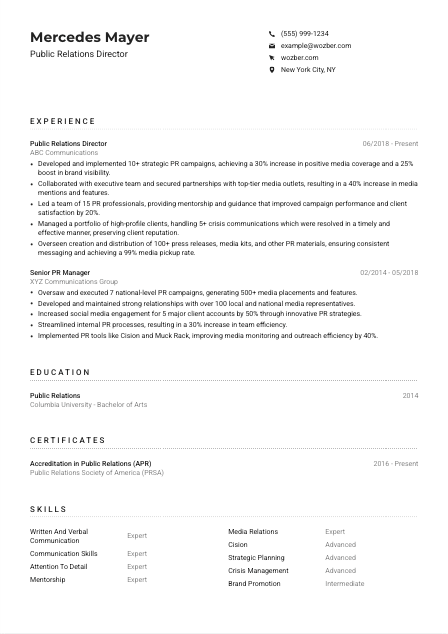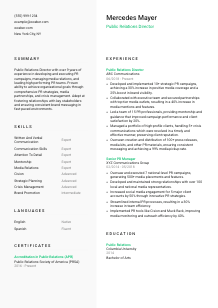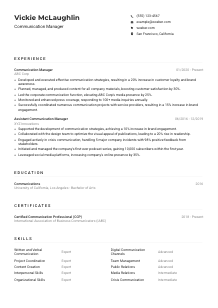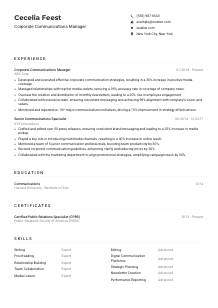Public Relations Director Resume Example
Spinning headlines, but your resume feels buried in the back pages? Shout out with this Public Relations Director resume example, crafted using Wozber free resume builder. Discover how to position your strategic narratives in sync with job expectations, making your career trajectory newsworthy and always in the spotlight!

How to write a Public Relations Director Resume?
Welcome, aspiring Public Relations Director! Delving into the vibrant world of PR demands not only a flair for strategic communication but also a standout resume that captures your capability to steer perceptions and build enduring brand images. With the aid of the free resume builder from Wozber, we'll navigate through the craft of constructing a resume tailored specifically for a Public Relations Director.
This guide promises to transform your professional narrative into a captivating saga that not only meets the job requirements but positions you as the leading candidate. Let's create a resume that turns heads, with an ATS-friendly resume template and insights for ATS optimization.
Personal Details
First impressions in the PR world are everything. Your resume's personal details section must resonate with the aura of a Public Relations Director. We're here to make sure every word in this section works hard to introduce you as the polished professional you are, setting the stage for the rest of your resume.
1. Spotlight Your Name
Think of your name as the brand logo at the top of your resume. It should be distinct and make a statement. A slightly larger font size ensures it's the first thing that catches the employer's eye, much like a well-crafted headline in a press release.
2. Job Title Precision
Right below your name, mirror the job title for which you're applying. This immediate match resonates with the ATS and positions you as an exact fit. For this role, placing 'Public Relations Director' front and center aligns perfectly with your target.
3. Essential Contact Info
In the fast-paced PR world, contacts are crucial. Include a professional email address and phone number to make sure potential employers can reach you without a hassle. Misplaced digits or complex email addresses can mean missed opportunities.
4. Location Match
Living in or willingness to relocate to the job's location is often a deal-breaker. Mention 'New York City, NY' prominently if that's your current location or your intended move, echoing the job's specifications and ensuring you're seen as a practical candidate.
5. Virtual Professionalism
In today's digital age, a LinkedIn profile or personal website is your online portfolio. Ensure it's updated and mirrors your resume, showcasing a proactive approach and offering a deeper dive into your professional journey.
Takeaway
Your contact information is more than mere details; it's the start of your story. Make it professional, concise, and aligned with your career goals. It's your introduction before you've even had the chance to speak.





Experience
The Experience section is your spotlight moment. It's where you chronicle your journey through the realms of Public Relations, painting a picture of a seasoned professional ready to take the helm as a Public Relations Director.
- Developed and implemented 10+ strategic PR campaigns, achieving a 30% increase in positive media coverage and a 25% boost in brand visibility.
- Collaborated with executive team and secured partnerships with top‑tier media outlets, resulting in a 40% increase in media mentions and features.
- Led a team of 15 PR professionals, providing mentorship and guidance that improved campaign performance and client satisfaction by 20%.
- Managed a portfolio of high‑profile clients, handling 5+ crisis communications which were resolved in a timely and effective manner, preserving client reputation.
- Overseen creation and distribution of 100+ press releases, media kits, and other PR materials, ensuring consistent messaging and achieving a 99% media pickup rate.
- Oversaw and executed 7 national‑level PR campaigns, generating 500+ media placements and features.
- Developed and maintained strong relationships with over 100 local and national media representatives.
- Increased social media engagement for 5 major client accounts by 50% through innovative PR strategies.
- Streamlined internal PR processes, resulting in a 30% increase in team efficiency.
- Implemented PR tools like Cision and Muck Rack, improving media monitoring and outreach efficiency by 40%.
1. Sync With Job Requirements
Begin by weaving in achievements that echo the job description. If it mentions 'developing strategic PR campaigns,' highlight exactly that, just like the example resume showcasing a '30% increase in positive media coverage' thanks to strategic campaigns.
2. Structure That Tells a Story
Your experience must unfold like a well-curated portfolio. Starting from your most recent role, detail your journey in PR, ensuring each bullet point is a testament to your strategic insights, leadership qualities, and proven results.
3. Quantify Your Narratives
In PR, your value is often measured by the visibility and engagement you generate. Use percentages and numbers to demonstrate your successes, like a '25% boost in brand visibility,' making your contributions tangible and compelling.
4. Relevance is Key
While your varied experience is valuable, concentrate on roles and responsibilities directly linked to PR. Highlighting your role in crisis management or media relations directly aligns with the expectations for a Public Relations Director.
5. Evidence of Leadership
Leadership experience is non-negotiable. If you've mentored a team or led complex campaigns, it's crucial to showcase this. Statements like 'Led a team of 15 PR professionals' directly hit the marker for leadership qualities.
Takeaway
Leverage your experiences to showcase a trajectory that not only meets but exceeds the PR Director role's expectations. Each sentence should be a strategic communication about your capabilities, just as you would manage your clients' storytelling.
Education
Education in the realm of Public Relations is not merely about the degrees obtained; it's about demonstrating a foundation of knowledge critical for strategic thinking and effective communication. Let's tailor this to underscore your suitability for the PR Director role.
1. Meet the Basic Requirements
Start with the non-negotiables. A 'Bachelor of Arts in Public Relations' precisely meets the job's criteria. If you possess a higher degree, like a Master's preferred by the job description, make sure it's highlighted and positioned as an advantage.
2. Structure for Clarity
Keep this section neat and transparent. Position your highest degree prominently and work backward. This clarity shows an organized mind, a critical trait for a Public Relations Director managing multiple projects and campaigns.
3. Alignment With Job Demands
Your education should reflect the professional you are today. For the PR Director role, focusing on your major directly related to PR underlines your specialized training and theoretical grounding in the field.
4. Relevant Courses and Extracurriculars
It's not just about the degrees; relevant courses, workshops, or memberships in PR societies (if you have them) add layers to your academic profile, showcasing a continuous journey of learning and professional development.
5. Highlight Achievements
Did you graduate at the top of your class, or lead a significant university project? While these may not be the main focus, they add depth to your profile, indicating a history of leadership and excellence.
Takeaway
Remember, your education section is not just a list. It's a narrative of your academic journey, underscoring your dedication to the craft of Public Relations. Ensure it resonates with the job at hand and sets a solid foundation for your professional expertise.
Certificates
In a field as dynamic as Public Relations, certifications can be your edge, showing commitment to your craft. Whether it's APR or a specialized media relations certification, let's highlight how these empower you for the Public Relations Director role.
1. Job Requirements First
If the job listing mentions specific certifications like APR, that's your cue. Putting your 'Accreditation in Public Relations (APR)' front and center confirms you meet and perhaps exceed the required standards.
2. Quality Over Quantity
Choose certifications that showcase your expertise in areas directly relevant to a PR Director role. Highlighting your prowess in strategic communication and media relations through certifications sets you apart as a learned and updated professional.
3. Timely Updates
The PR landscape is ever-evolving. Show that you're committed to keeping pace by regularly updating your certifications and knowledge base. Fresh certifications signal an ongoing engagement with the latest in PR trends and technologies.
4. Display With Pride
Don't be shy about your professional development achievements. Present them prominently on your resume, providing dates to showcase recency and relevance. These are badges of honor that speak volumes about your dedication.
Takeaway
Certifications are more than just accolades; they are testament to your never-ending journey in mastering the art of Public Relations. Let them shine on your resume as markers of your commitment and foresight in the field.
Skills
Skills for a Public Relations Director extend beyond mere technical competencies; they encompass the art of communication, strategic foresight, and adept crisis management. Here's how to align your skill set with the high demands of the role, using direct extracts from the job description.
1. Tailor to the Job Description
Start by listing skills that the job description explicitly mentions, like 'Exceptional written and verbal communication skills' or 'Proficiency in PR tools such as Cision, Muck Rack.' This direct correlation signals to both the hiring manager and the ATS that you're a prime candidate.
2. The Right Mix
Blend hard and soft skills to present a comprehensive picture. Show that you're not only technically proficient with tools like 'Cision' and 'Muck Rack' but also excel in 'strategic planning' and 'crisis management,' critical competencies for a PR Director.
3. Keep It Organized
While it may be tempting to list every skill under the sun, focus on those most relevant to the role. A well-organized skills section, prioritized by relevance to the Public Relations Director position, makes a stronger impact than a crowded list.
Takeaway
Think of the skills section as the highlight reel of your professional toolbox. Each skill you list is a carefully chosen tool, ready to tackle the challenges of the Public Relations Director role. Showcase them wisely, and keep sharpening them to stay ahead in the field.
Languages
The ability to navigate different languages can be a significant asset in the diverse landscape of Public Relations. Whether it's crafting multilingual campaigns or liaising with international media, let's position your language skills as a key component of your global PR strategy.
1. Direct Match
If the job demands proficiency in a specific language, like 'Must have the ability to read complex texts in English,' ensure it's listed prominently. This assures employers of your capability to engage effectively in your primary market.
2. Global Communication
Even if not specified, additional languages can give you an edge, especially in international PR roles. Listing your fluency in other languages like 'Spanish: Fluent' suggests you're well-equipped to handle global campaigns and communications.
3. Honesty in Proficiency
Be transparent about your level of proficiency. Using terms like 'Native' or 'Fluent' provides a clear understanding of your capabilities, ensuring you're entrusted with tasks that match your linguistic strengths.
4. The Role's Scope
Consider the geographic and demographic reach of the PR campaigns you'll be managing. A PR Director role with a global focus immensely benefits from multiple language proficiencies, enabling broader engagement and nuanced communication strategies.
Takeaway
Your linguistic skills offer a window to the world, enabling richer, more diverse communications. Treat every language you know as a key to unlocking new audiences and markets, enriching your PR campaigns with global resonance and inclusivity.
Summary
The summary section is where you encapsulate your professional identity, showing potential employers why you're the perfect candidate for the Public Relations Director role. Here, brevity meets substance, providing a powerful overview of your capabilities and achievements.
1. Comprehend the Job's Core
Absorb the essence of the job posting to understand what the employer values most. A summary that begins with 'Public Relations Director with over 9 years of experience in developing and executing PR campaigns' immediately aligns with the strategic focus of the role.
2. Start with Impact
Engage right from the start with a statement that highlights your profession and experience level. This primes the reader on your proven track record and sets the tone for the detailed achievements that follow.
3. Reflect the Job's Requirements
Incorporate keywords and phrases from the job description into your summary. Linking your expertise in 'media relations' and 'crisis management' directly to the role's demands shows a tailored fit.
4. Precision and Punch
Aim for a summary that's concise yet rich with information. It should grab attention like a well-crafted press headline, making the hiring manager eager to dive deeper into your resume.
Takeaway
Treat the summary section as your personal pitch, a chance to convey your unique value proposition within a snapshot. Craft it with care, ensuring it sings in harmony with the expectations for the Public Relations Director role.
Igniting Your Public Relations Journey
You're all set to craft a Public Relations Director resume that doesn't just pass the ATS test but also captures the essence of what you bring to the table. Remember, every section of your resume is a chapter in your professional saga, portraying you as the protagonist primed for success. Utilize Wozber's free resume builder, including its ATS-friendly resume templates and ATS resume scanner, to ensure your document is not just compliant but compelling. Let your resume be the beacon that guides you to your next great opportunity in the world of Public Relations.

- Bachelor's degree in Public Relations, Communications, or a related field.
- Master's degree preferred.
- A minimum of 8 years of experience in Public Relations, with at least 3 years in a leadership or managerial role.
- Proven ability to develop and execute successful PR campaigns at both local and national levels.
- Exceptional written and verbal communication skills with a strong attention to detail.
- Proficiency in PR tools such as Cision, Muck Rack, or similar platforms.
- Accreditation in Public Relations (APR) is a plus.
- Must have the ability to read complex texts in English.
- Must be located in or willing to relocate to New York City, NY.
- Develop and implement strategic PR campaigns to achieve organizational goals and maintain a positive public image.
- Collaborate with key stakeholders to identify media opportunities and manage relationships with media representatives.
- Oversee the creation of press releases, media kits, and other PR materials to ensure consistent messaging and high quality.
- Manage crisis communications and handle PR issues in a timely and effective manner.
- Provide leadership, guidance, and mentorship to the PR team ensuring their professional development and overall success.















